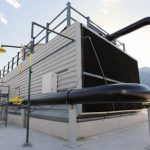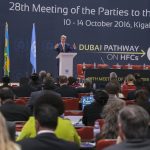Trump Or No Trump, America’s Mayors And Governors Have A Post-Paris Plan To Save The Climate
Shortly after Trump announced his intent to withdraw from the Paris agreement on Thursday–saying that he “was elected to represent the citizens of Pittsburgh, not Paris”–the mayor of Pittsburgh reaffirmed his city’s support for the agreement (and pointed out that his constituents voted overwhelmingly for Clinton). By the end of the day, 82 U.S. mayors had signed a pledge to adopt the agreement. By Monday, that number had grown to more than 200.
In a separate declaration released on Monday called We Are Still In, a group of 125 mayors, nine governors, 183 university presidents, and 902 businesses, including Apple, Google, Ikea, and Target, said that they continued to support climate action–and many leaders believe that it will be possible to meet the U.S.’s original pledge to reduce emissions, despite Trump.
“What this [withdrawal] is immediately doing is creating a galvanizing moment,” says Seth Schultz, director of research, measurement, and planning for C40, a global network of megacities committed to fighting climate change. “You’ve just seen this very swift and immediate response saying the Trump administration pulls out of this, but America is not stepping away from this–from our commitment, from our responsibility to each other and to the rest of the world.”

The governors of New York, California, and Washington, states that represent more than 20% of the U.S. population (and about 10% of the total emissions), also launched a new alliance called the Climate Alliance pledging to meet the goals of the Paris agreement. Thirteen states had joined by Monday. Seventeen governors also released individual statements in support of the agreement.
Bloomberg Philanthropies will donate $15 million to the UN agency that coordinates the operations of the Paris agreement–money that it won’t be getting from the U.S. federal government–and will then work with all the cities, states, and businesses that take climate action to measure their plans to reduce emissions, and submit a new pledge totalling those commitments, along with reports on progress, to the UN.
While only nations are officially party to the Paris agreement, Patricia Espinosa, the executive secretary of the UN Framework Convention on Climate Change (UNFCCC), said in a press release that the organization “welcomes the determination and commitment” from cities, states, and businesses. According to a representative from Bloomberg Philanthropies, the UN will accept the emissions reduction numbers reported by the new organization even though it is not a national government. The group’s pledge and reports will be in parallel to what the federal government was supposed to provide (and is still supposed to provide until the U.S. officially withdraws, a process that will likely take until November 2020).
In the Paris agreement, the pledges each country made to reduce emissions were voluntary, and many of those working on the state and local level believe that they can still be accomplished. The U.S. pledged to cut emissions 26% to 28% by 2025 compared to 2005 levels, and the country has already achieved half of those cuts.
“These pledges were bottom up,” says Carl Pope, senior advisor to Michael Bloomberg. “They were what people wanted to do. And we believe there will be enough things people want to do that when we add them all up it will take us the rest of the way.”
Many cities already have ambitious plans underway. Los Angeles started working on its Sustainable City Plan in 2014, before the Paris agreement was signed, and set a goal to reduce greenhouse gas emissions in line with what science said was necessary, or 45% below 1990 levels by 2025 (and 80% lower by 2050). Its city-owned power company stopped contracting with one coal plant in 2015, and will stop using another other–Intermountain Power Plant in Utah–by 2025.

A $1.2 billion investment will help L.A.’s rail network more than double. A new electric car-sharing fleet introduced in low-income neighborhoods aims to help shift those most impacted by air pollution to cleaner transportation. The police department is testing Teslas and electric BMWs. L.A. also led a coalition of 30 cities to make purchase orders for new electric cars–telling car companies they would spend $10 billion. The announcement came in March as Trump announced a review of federal efficiency standards.
“That wasn’t initially intended to be in the face of Trump’s rollback of fuel efficiency standards, but certainly it’s a counterpoint at this stage showing that cities are going to create the demand for these vehicles and put them to use,” says Matt Petersen, the city’s chief sustainability officer.
New York City, which plans to reduce its emissions 80% against a 2005 baseline by 2050, has implemented programs like the Green Housing Preservation Program, which helps small apartment buildings become more efficient in exchange for promising to keep rent affordable, and is moving to power city buildings with renewable energy. Washington, D.C., has expanded its successful bike-sharing program to make it affordable for low-income residents. Seattle, which plans to reach zero net emissions by 2050, is focusing partly on making the city more walkable and bikable and improving public transit.
While several cities already have ambitious plans, Trump’s announcement has motivated city officials to do even more. “All these cities have all made commitments to reduce emissions, and they’re delivering on those,” says Petersen. “Now we’re going to see what additional actions can be taken in the next few years to accelerate our greenhouse gas reductions while growing the clean economy of today. That’s what we’re doing. It’s not just rhetoric. We’re really trying to back it up with specific actions where it makes sense for mayors at the political level, along with their staff, to come together, see how we can transform the markets, and learn from each other.”
The announcement is likely to have an even greater impact on cities that are earlier in the process of reducing emissions. “There are a lot of cities that have large ambitions but not yet strong plans,” says Pope. “I think a lot of this will be on the execution side.”
The list of mayors who have signed the pledge to adopt and honor the Paris commitment includes Republican mayors, such as the mayors of Miami and San Diego, and mayors of smaller cities such as Carmel, Indiana, where the city is making plans to make streets more walkable and has switched streetlights to LEDs. Des Moines (mentioned by Mike Pence in a variation of “Pittsburgh, not Paris,” saying the president was “more concerned with Des Moines than Denmark”) is on list. Cities in the heart of coal country, like Blacksburg, Virginia, are on the list. Cities from every part of the U.S., including Houston, Milwaukee, Phoenix, and Knoxville, are on the list.
A C40 report published in December 2016 estimated that if all cities with populations larger than 50,000 took climate action, it would account for more than a third of the pledge the U.S. made for the Paris agreement. (There are nearly 500 cities of that size in the U.S., and though fewer than half have pledged to support Paris so far, that number is growing.)
Compared to many other countries, U.S. cities and states have more autonomy in decision-making. Local government can often regulate transportation and buildings; cities also participate in creating the Uniform National Building Code, which is run by a private body rather than the federal government. Some cities, such as L.A., can directly shift to clean electricity. Others can negotiate with utilities to make that happen.
“Even three years ago, it was sort of assumed that electricity was controlled by monopoly utilities,” says Pope. “But that model’s been breaking down.” Salt Lake City, for example, negotiated with its utility to get a deal for 100% renewable electricity (and save residents money on power bills). Twenty-nine U.S. cities have now committed to renewable electricity.
Some states also have ambitious plans, and some have already taken ambitious action. On a press call immediately after Trump’s announcement, California Governor Jerry Brown made the point that despite following policies tougher than the Paris agreement calls for, the state’s economy increased 40% faster than the rest of the U.S. in 2016. “California, we’re all in,” he said. “We’re on the field ready for battle. While our president may be AWOL in the battle against climate change, we’re not.”
There are obvious losses from the lack of federal action. Obama planned to regulate methane from the oil and gas industry on federal land, for example. But if oil and gas emissions might be higher than expected, “we’re going to see bigger reductions from the electricity sector and in buildings than Obama projected,” says Pope. He estimates that if the utility sector continues the pace of the last three years–driven largely by market forces like the collapse of coal because of natural gas and the rise of renewables–the sector’s emissions would drop to 50% of their 2005 level by 2025. “That in itself would close the gap,” he says, letting us hit our Paris targets.
The federal government also could have provided funding to help smooth the transition to clean power–but federal money hasn’t been a major factor in how far cities have already come. “We need to finance the transition to a low-carbon economy, and we need to do it very quickly,” says Schultz. “So where that comes from is important, and the national government has a huge role in that, and that is also at risk. But you talk to a lot of the mayors in C40 and they are, I’m telling you, completely unfazed because they haven’t gotten that money for years. And they’re figuring out how to do it anyway.”
If the international community reacts negatively to the pull out, he says, that could also make it harder for cities and states to do deals or get international financing. But despite these challenges, the overall impact of Trump’s decision may be positive, because it has launched so many local governments and businesses into action. “I think emotionally, and in terms of the ambition, it’s actually not hurting cities at all,” he says. “It’s only making them redouble their efforts. It’s making them stronger advocates. It’s making them more vocal . . . hearing that [the U.S.] is pulling out of the Paris agreement, they haven’t even batted an eye. Just the opposite. It’s been, we’re doubling down. We’re taking this to the streets. You’re giving us more confidence and we’re going to shoulder the load.”
In the days after Trump pulled out of the historic international climate agreement, bipartisan groups of officials from around the country are laying out plans to make create a clean economy in the U.S., regardless of the president’s policies.
Shortly after Trump announced his intent to withdraw from the Paris agreement on Thursday–saying that he “was elected to represent the citizens of Pittsburgh, not Paris”–the mayor of Pittsburgh reaffirmed his city’s support for the agreement (and pointed out that his constituents voted overwhelmingly for Clinton). By the end of the day, 82 U.S. mayors had signed a pledge to adopt the agreement. By Monday, that number had grown to more than 200.
Fast Company , Read Full Story
(38)














